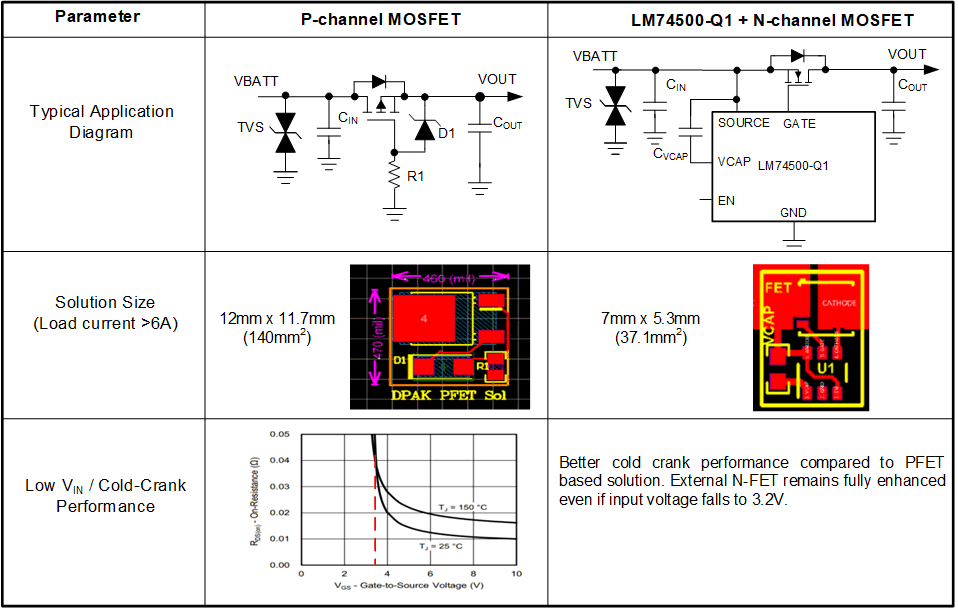SLVAE57B February 2021 – October 2021 LM5050-1 , LM5050-2 , LM5051 , LM66100 , LM74202-Q1 , LM74500-Q1 , LM74610-Q1 , LM74700-Q1 , LM74720-Q1 , LM74721-Q1 , LM74722-Q1 , LM7480-Q1 , LM7481-Q1 , LM76202-Q1 , SM74611 , TPS2410 , TPS2411 , TPS2412 , TPS2413 , TPS2419
- Trademarks
- 1 Introduction
- 2 Reverse Battery Protection
- 3 ORing Power Supplies
- 4 Reverse Battery Protection using MOSFETs
- 5 Reverse Polarity Protection vs Reverse Current Blocking
- 6 What is an Ideal Diode Controller?
- 7 Automotive Transient protection with Ideal Diode Controllers
- 8 ORing Power Supplies with Ideal Diode Controllers
- 9 Integrated Ideal Diode Solution
- 10Summary
- 11References
- 12Revision History
5.2 Performance Comparison of P-Channel and Reverse Polarity Protection Controller Based Solution
P-channel MOSFET based reverse polarity protection is a very commonly used scheme in industrial and automotive applications to achieve low insertion loss protection solution. A low loss reverse polarity protection solution can be realized using LM74500-Q1 with an external N-channel MOSFET to replace P-channel MOSFET based solution. LM74500-Q1 based reverse polarity protection solution offers better cold crank performance (low VIN operation) and smaller solution size compared to P-channel MOSFET based solution. Figure 5-2 compares the performance benefits of LM74500-Q1 + N-channel MOSFET over traditional P-channel MOSFET based reverse polarity protection solution.
As shown in Figure 5-2, for a given power level LM74500-Q1+ N-channel MOSFET solution can be three times smaller than a similar power rated P-channel MOSFET solution. Also as P-channel MOSFET is self biased by simply pulling it's gate pin low and thus P-channel MOSFET shows poorer cold crank performance (low VIN operation) compared to LM74500-Q1. During severe cold crank where battery voltage falls below 4 V, P-channel MOSFET series resistance increases drastically as shown in Figure 5-2. This leads to higher voltage drop across the P-channel MOSFET. Also with higher gate to source threshold (VT) this can sometimes lead to system reset due to turning off of the P-channel MOSFET. On the other side, LM74500-Q1 has excellent severe cold crank performance. LM74500-Q1 keeps external FET completely enhanced even when input voltage falls to 3.2 V during severe cold crank operation.
 Figure 5-2 Performance Comparison of
P-channel MOSFET and LM74500-Q1 Based Reverse Polarity Protection
Solution
Figure 5-2 Performance Comparison of
P-channel MOSFET and LM74500-Q1 Based Reverse Polarity Protection
Solution